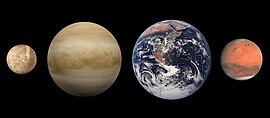
Back Planeet Afrikaans Planet ALS ፕላኔት Amharic Planeta AN Dweligende tungol ANG ग्रह ANP كوكب Arabic ܦܠܝܛܐ ARC كوكب ARY كوكب ARZ
A planet is a large object such as Venus or Earth that orbits a star. Planets are smaller than stars, and they do not make light.
Jupiter is the biggest planet in the Solar System, while the smallest planet in the Solar System is Mercury.
Planets are shaped like a slightly squashed ball (called a spheroid). Objects that orbit planets are called satellites. A star and everything which orbits it are called a star system.
There are eight planets in the Solar System. Pluto used to be called a planet, but in August 2006, the International Astronomical Union decided it was a dwarf planet instead. There are four more known dwarf planets in the Solar System, Ceres, Makemake, Eris and Haumea.
The name "planet" is from the Greek word πλανήτης (planetes), meaning "wanderers", or "things that move".
Until the 1990s, people only knew the planets in the Solar System. Since then 4,905 extrasolar planets (exoplanets) have been discovered in 3,629 planetary systems (January 2022 data). The count includes 808 multi-planetary systems. Known exoplanets range in size from gas giants about twice as large as Jupiter down to just over the size of the Moon. About 100 of these planets are roughly the size as Earth. Nine of these orbit in the habitable zone of their star.[1][2]
- ↑ "NASA discovery doubles the number of known planets". USA TODAY. 10 May 2016. Retrieved 10 May 2016.
- ↑ Schneider, Jean (16 January 2013). "Interactive Extra-solar Planets Catalog". The Extrasolar Planets Encyclopaedia. Retrieved 2013-01-15.
© MMXXIII Rich X Search. We shall prevail. All rights reserved. Rich X Search

